
Coedpoeth is a village and community in Wrexham County Borough, Wales. The built-up area with Minera had a population of 5,723 in the 2011 census.

Penmynydd, meaning "top of the mountain" in Welsh, is a village and community on Anglesey, Wales. It is known for being the birthplace of the Tudors of Penmynydd, which became the House of Tudor. The population according to the United Kingdom Census 2011 was 465. The community includes the village of Star and the hamlet of Castellior.

Lower Machen is a small hamlet of 19 houses on the A468 road at the very western edge of the city of Newport, South Wales.

Trevalyn Hall in Rossett, a Grade II* listed building, is an Elizabethan manor house near Wrexham in Wales. It was built by John Trevor in 1576. The Trevor family of Trevalyn were one of the leading families in East Denbighshire by about 1600 with numerous estates in both Flintshire and Denbighshire. The Plas Teg estate in Hope, Flintshire was also acquired by the Denbighshire branch of the family when it was purchased from a cousin by Sir John Trevor I (1563–1630) and it was he who built the present Plas Teg house in 1610.

Plas Teg is a Grade I listed Jacobean house in Wales. It is near the village of Pontblyddyn in Flintshire, between Wrexham and Mold. It is considered to be one of the finest examples of Jacobean architecture in Wales, and the finest in North Wales.
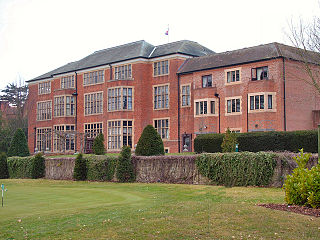
Hanbury Manor, centred on the multi-wing Hanbury Manor Hotel, is a converted late-Victorian country house and adjoining golf course in Thundridge, north of Ware, Hertfordshire, some 10 miles (16 km) north of Greater London. It is part of a leisure retreat and country club owned by Marriott Hotels. The house is Grade II* listed on the National Heritage List for England.

Rossett Hall is a mid-eighteenth century Grade II listed Georgian building situated in the village of Rossett, Wrexham County Borough, in the north of Wales. A former manor house, it is now a hotel under the Everbright Group.

St Ffinan's Church, Llanffinan is a small 19th-century parish church built in the Romanesque revival style, in Anglesey, north Wales. There has been a church in this area, even if not on this precise location, since at least 1254, and 19th-century writers state that St Ffinan established the first church here in the 7th century. The church was rebuilt in 1841, reusing a 12th-century font and 18th-century memorials, as well as the cross at the eastern end of the roof.
Chelford Manor House stands to the southeast of the village of Chelford, Cheshire, England. It dates from the early 17th century. An extension was made to it in 1671, and more alterations and additions were carried out in the 19th and 20th centuries. The last addition was made for Colonel Dixon of Astle Hall. The house is timber-framed on a stone plinth. The infill is either brick or rendered brick. It is roofed in slate and cement tiles. It is a "complex" building, with parts in two storeys, and other parts in three storeys. The house is recorded in the National Heritage List for England as a designated Grade II* listed building. To the north of the manor house is a former tithe barn. This is also timber-framed with brick infill, and is listed at Grade II.

Crabwall Manor is a former country house, later a hotel, in the village of Mollington, Cheshire, England. The present building dates from the 18th century. It replaced an early 17th-century house built for the Gamul family. The house was originally a "modest brick cottage" and it was refaced in the early 19th century. Figueirdo and Treuherz comment that this give it "the appearance of a toy fort". The interior was remodelled in about 1900. It has since been converted into a hotel, with extensions added in 1987. It is constructed in orange and yellow brick with red sandstone dressings. The roof is in Welsh slate and there are three brick chimneys. The building is in two storeys, with an entrance front of three bays. At the corners are octagonal towers. The central bay protrudes and forms a two-storey porch; it is supported by diagonal buttresses. The tops of the porch and towers are crenellated. The building is recorded in the National Heritage List for England as a designated Grade II listed building.
Hampton Old Hall is a country house in the parish of No Man's Heath and District, Cheshire, England. It is dated 1591, and was built for the Bromley family. There have been subsequent additions and alterations. Figueirdo and Treuherz describe it as "a puzzling and ambitious house, perhaps never completed". The main block is the earliest section, and consists of a close-studded timber-framed range with three gables. Adjoining it is a 17th-century timber-framed porch. Behind the porch is a south wing in brick and stone. The architectural historian Nikolaus Pevsner comments "there must be quite an interesting story behind all this". The house has been "restored and furnished ... in a solid and traditional farmhouse manor". It is designated by English Heritage as a Grade II* listed building. A timber-framed barn to the north of the hall, dating from the 17th century, is listed at Grade II.
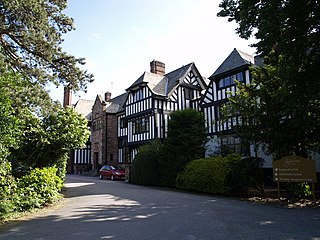
Inglewood is a house to the north-west of the village of Ledsham, Cheshire, England. It was built in 1909, but is dated 1915. The house was built for Frederick H. Fox, a Liverpool millionaire who made his fortune in marine insurance. It was later one of the seats of the Gordon family. As of 2011 it is a hotel called Inglewood Manor Hotel. The house is mainly half-timbered, with stone dressings, and brick chimneys decorated with diapering. It is roofed with Lakeland slate. Its architectural style is late Arts and Crafts. The house has a rectangular plan, with three fronts in two and three storeys. The entrance is on the east front, which has eight bays; the south and west fronts each have five bays. On the south side is a balcony overlooking the gardens. The house is recorded in the National Heritage List for England as a designated Grade II listed building. Also listed Grade II are the south and west terrace walls of the garden, and the east terrace walls and a pergola.

Soss Moss Hall is a former manor house in the parish of Nether Alderley, Cheshire, England. It was built in 1583 for Thomas Wyche. The architectural writers Figueirdo and Treuherz consider that, because of duplication of some of the timbers, it was built in two stages. Between 1835 and 1940 the kitchen of the house was used as Nether Alderley Methodist Chapel. The house was extended in the early 17th century and alterations were made during the 20th century. It is a timber-framed building on a sandstone plinth, with some repairs in brick. The infill is partly with brick, and partly with plaster. It is roofed in Kerridge stone slate, with stone ridges. The house has a H-shaped plan. It has two storeys, the north front having three gables, all of which have black-and-white herringbone decoration. On the left side is a massive stone chimney with three stacks, serving three fireplaces; it contains garderobes. The house is recorded in the National Heritage List for England as a designated Grade II* listed building.
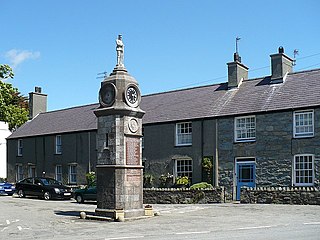
Llanfechell is a village in Anglesey, Wales. It is the largest of several small villages and dispersed settlements that make up Mechell Community Council area. It is 11 miles (18 km) east of Holyhead, and 5.6 miles (9 km) west of Amlwch, in the north of the island.
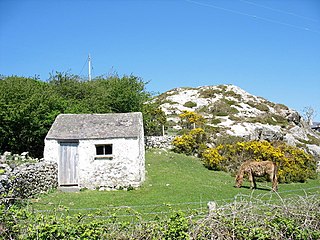
Llanddyfnan is a village and community in Anglesey, Wales, located 3.5 miles (5.6 km) north east of Llangefni, 6.6 miles (10.6 km) north west of Menai Bridge and 7.1 miles (11.4 km) west of Beaumaris.

Loxhore is a small village, civil parish and former manor in the local government district of North Devon in the county of Devon, England. The parish, which lies about five miles north-east of the town of Barnstaple, is surrounded clockwise from the north by the parishes of Arlington, Bratton Fleming and Shirwell. In 2001 its population was 153, down from the 202 residents it had in 1901.

St Dyfnan's Church is a medieval church in the village of Llanddyfnan, Anglesey, Wales. The building dates from the 14th century and underwent extensive renovations in the mid-19th century. The church lies north from the B5109 road. It was designated as a Grade II*-listed building on 5 December 2007.
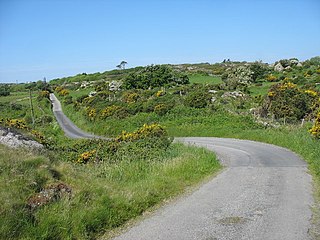
Mechell is a community in the north of the Isle of Anglesey, Wales. Llanfechell is the largest village within the community area. Tregele, Llanfflewyn, Mynydd Mechell, Bodewryd, Rhosbeirio and Carreglefn have a more dispersed settlement pattern. The antiquity of these settlements is shown by the presence of 6 medieval churches and some 16 more ancient sites dating back into prehistory.
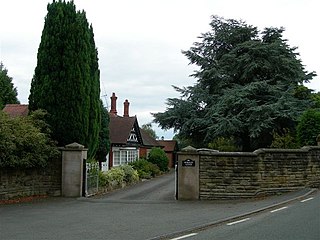
Horsley Hall was a Jacobethan-style house with formal gardens, near to Gresford, Wrexham County Borough, that was destroyed in 1963.
Presaddfed Hall is a small Grade II* listed country house that stands amongst woodlands to the northeast of Bodedern, Wales, at the southern tip of Llyn Llywenan. Today the hall is a self-catering accommodation for rent. A walled garden lies to the east of the house.

















